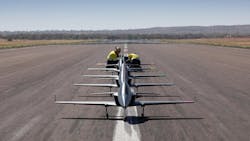Boeing tests autonomous, artificial intelligence-enable jets in Australia
In this week’s roundup from the Association for Unmanned Vehicle Systems International, which highlights some of the latest news and headlines in unmanned vehicles and robotics, Boeing makes significant progress in the development of its autonomous systems technology and drones recreate accident scenes for analysis by law enforcement and use in legal cases.
Boeing completes tests of its advanced autonomy technology
Boeing has announced that it recently completed flight tests with five high-performance surrogate jets operating autonomously in a team at the new Queensland Flight Test Range in Cloncurry, Australia.
The 11-foot aircraft were used to test Boeing’s advanced autonomy technology, including on-board command and control and data sharing capabilities.
“The tests demonstrated our success in applying artificial intelligence algorithms to ‘teach’ the aircraft’s brain to understand what is required of it,” says Emily Hughes, director of Phantom Works International.
“The data link capabilities enabled the aircraft to communicate with the other platforms so that they could collaborate to achieve a mission.”
Testing lasted 10 days, with aircraft being added gradually until the five operated together. The aircraft reached speeds of 167 miles per hour during testing.
“With the size, number and speed of aircraft used in the test, this is a very significant step for Boeing and industry in the progress of autonomous mission systems technology,” Hughes says.
According to Boeing, the flight tests were the final milestone delivered in partnership with the Queensland government as part of Boeing’s Advanced Queensland Autonomous Systems Platform Technology Project. Boeing has worked with more than 90 personnel from a number of small-to-medium enterprises during the project, including RFDesigns, Amber Technology Ltd., Premier Box, McDermott Aviation and Five Rings Aerospace.
Boeing says that technology and capabilities proven under this program will form part of the Boeing Airpower Teaming System and future Boeing autonomous platforms.
Drones help re-create crash scenes in Montana
When performed on foot and with manual processes, investigating car crashes on the highway can not only take a lot of time, but it can also be extremely dangerous for officers.
More than 20 years ago, the Montana Highway Patrol (MHP) would spend hours measuring lines with manual tools, which yielded limited data while putting officers in harm’s way.
“A lot of scenes that we did … it was me and one other guy, and that was it,” says Shawn Hazelton, a sergeant with MHP, via Government Technology. “You would hope people would pay attention and slow down for your lights.”
During the 1990s, departments started using total stations, an electronic surveying device, to map out a crash scene. Total stations were an upgrade, but they still required multiple people, and would only lead to about 150 data points being collected. According to Aaron Freivalds, MHP trooper and traffic homicide investigator, the process using total stations would take about three hours. Later on, that time would be cut in half, and the amount of required manpowered would be reduced thanks to robotic total stations, but officers were still at danger.
Fast forward some 20-plus years, and an investigator’s feet don’t necessarily have to touch the road nowadays when investing a crash scene, as a drone with a camera can be flown by a single officer parked near the scene.
“I can go out by myself and process a quarter-mile scene in 30 minutes without interfering with the flow of traffic, without having to walk in the roadway at all, and then take those photographs back to my office and finish processing the scene remotely,” Freivalds says.
Montana has distributed drones across the state, so as long as a pilot near the crash is available to fly an aircraft, an investigator doesn’t have to come to the scene if they are hours away from the incident.
A scene is re-created by uploading hundreds of high-resolution drone photos into a software program (for ease of use, Montana uses a product from company Pix4D). From there, the program creates a fully three-dimensional image via photogrammetry. The final product is the best part about the whole process, says MHP Trooper Philip Smart.
“A jury can really experience what the scene was like,” Smart says.
Photos taken from the sky reveal much more about crash scenes compared to traditional recording tools. Freivalds notes that if a driver or passenger was ejected onto some grass during an accident, officers can determine where the individual initially landed by looking at where the grass has been pressed down.
If an ejection occurs at night, Montana officers can utilize a thermal camera on a drone to locate the individual, which can help people get medical attention more quickly. It also decreases the need for expanded search parties.
“Rollover crashes can be very violent,” Hazelton says. “People can be thrown 100 feet or more from a crash scene. We would use our wrecker drivers at times to start searching an area. At night, you could only search as well as what your lighting is.”
Another instance where a drone can be beneficial is when a vehicle falls down a steep embankment into a river.
“When you’re in a place with plenty of contour like Montana, having a drone is certainly useful,” Smart says.
Compiled by Brian Sprowl, Associate Editor, AUVSI
Share your vision-related news by contacting Dennis Scimeca, Associate Editor, Vision Systems Design
SUBSCRIBE TO OUR NEWSLETTERS
